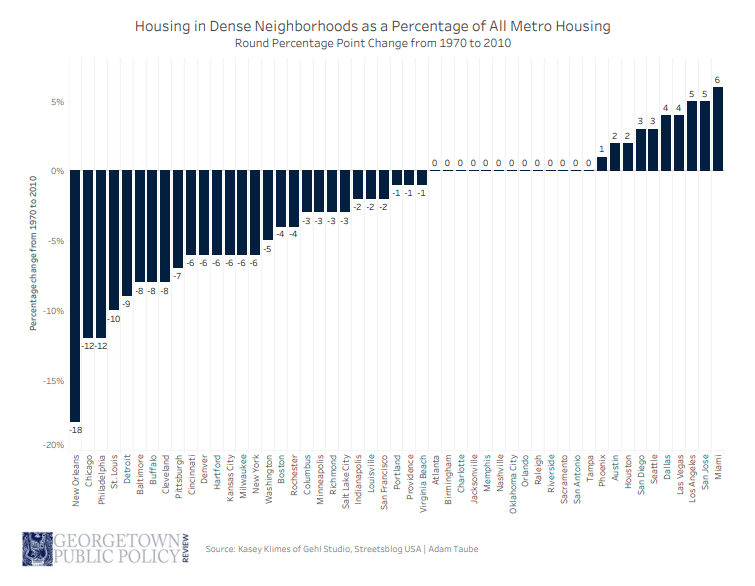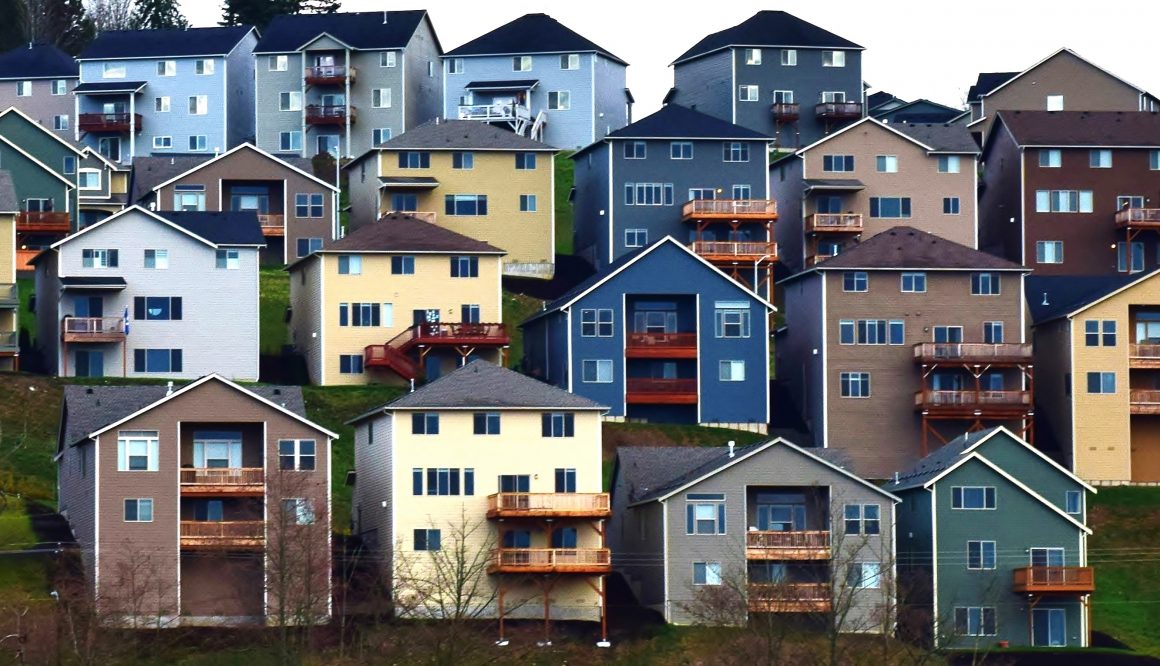Exclusionary zoning, a practice historically used to racially segregate communities, plagues issues across the political landscape, from climate change to education. This article is the first in a series on how exclusionary zoning perpetuates a discriminatory housing system that threatens our aging population, education system, and climate.
What is exclusionary zoning?
A cornerstone of the American dream is the idea of homeownership. Yet booming metropolitan areas throughout history have deliberately shut minorities out of this dream through exclusionary zoning and other discriminatory policies, which have divided neighborhoods by black and white, poor and middle-class, “undeserving” and “deserving.” And while the Fair Housing Act technically bars race-based discrimination, reality tells a different story.
At its most basic definition, exclusionary zoning is a policy that sets land use requirements, such as barring apartment buildings or setting minimum lot sizes. In practice, they keep certain residents (i.e. low-income residents and residents of color) from living in certain communities (i.e. wealthy and middle-class white communities) and keep property values for homeowners high. The dryness of land use policy often obscures its vital significance to modern segregation. Many local zoning codes are mind-numbingly dense, dated, and a surefire sedative even for housing policy wonks. However, their basic implications must be understood to end the damage of exclusionary zoning to racial and generational access to wealth, the health of the environment, the quality of schools, and more.
What’s the policy debate all about?
Conversations about housing policy usually revolve around a conflict between two camps: baby boomer NIMBYs (“not in my backyard”), whose neighborhood associations fight tooth-and-nail to keep their suburban communities in a historically static steady state, against millennial YIMBYs (“yes in my backyard”), whose activists associate the waves of crushing rent increases with the lack of housing supply. The generational divide mostly holds though there are some who cross the ideological picket lines, such as young Brooklynites and San Franciscans who decry changes to “neighborhood character.” But YIMBY-variety millennials argue opening the zoning code to denser varieties of housing—upzoning—would alleviate the supply problem and drive down prices.
What this conversation often misses is a common thread connecting the troubles of both generations. Americans treat housing as a wealth-building lifetime investment that encourages a massive accumulation of debt. Many older Americans spent their lives investing in detached, yarded colonials and now receive huge dividends from skyrocketing home values. For example, in 2017, the average Seattle homeowner made $119,000 in equity alone. It’s no coincidence that 75 percent of Seattle land is zoned for single-family housing. However, the incredible size of the appreciation creates a flawed incentive structure.

Consider the challenges of coastal empty nesters in the suburbs of major metropolitan areas. As their children move out and they retire, empty nesters are often outgrown by their homes. Large portions of their multilevel houses go unused and basic upkeep takes more of a physical toll. Empty nesters can try to sell their houses and move somewhere better suited to their routines and healthcare needs, but there’s a problem: because exclusionary zoning limits the housing stock to just single-family homes, empty nesters are forced to choose between moving away from their communities or staying in an impractical and sometimes dangerous house. To the extent diverse housing options like condos exist, their scarcity makes downsizing exorbitantly expensive, as in Boston. The high cost of single-family homes also prevents younger families from purchasing them. Suddenly, sitting on six or seven-digit equity can feel like winning the lottery and not being able to cash the ticket.
How does exclusionary zoning negatively affect elderly residents?
Among others, the most substantial problem for seniors stuck in metropolitan suburbs is healthcare. Some experts estimate that by 2050, people over 65 will make up more than 20 percent of the population, an increase of roughly 40 million new Medicare-eligible patients. But long-term care, the kind of healthcare service necessary for residents to maintain their independence with chronic conditions, such as mobility issues or Alzheimer’s, is not currently covered under Medicare in most circumstances.
What does healthcare have to do with exclusionary zoning? Neighborhoods built on exclusionary-zoned land are made for able-bodied families, from house design to reliance on cars. A Harvard study found almost 70 percent of households age 85 and older are missing critical safety features. Wealthy residents might have the means to hire long-term care and modify their homes to be more accessible, but even they are sometimes barred from making significant changes to their own property due to restrictive zoning ordinances. Middle-class residents largely rely on family members to cover errands and home repairs.
Some might argue this is a healthcare problem, not a housing problem. It’s both, but exclusionary zoning makes the problem much worse, illustrated best by how it shapes the transportation networks residents rely on day-to-day. As any suburban teenager knows, suburbs are intertwined with dependence on cars. Seniors are disproportionately both the victims and causes of car-dependent transportation violence. When seniors drive past their ability to do so safely—and they are, on average, driving seven to ten years beyond that time—crashes are more likely to be fatal. In addition, 80 percent of septuagenarians have arthritis, making it harder to use the steering wheel, brake, and accelerate. Yet in exclusively-zoned neighborhoods, the car is often the only lifeline to the rest of the community.
The research on isolation raises serious concerns for seniors in this position. Seniors experiencing social isolation are more likely to feel depressed and have issues sleeping. Isolation is correlated with early mortality with some researchers estimating it has the equivalent effect of smoking up to 15 cigarettes a day. Exclusionary zoning is not the primary driver of isolation, but it undoubtedly contributes by making it harder for seniors to go about their regular routines. Ultimately, seniors should have the choice to stay independent and be an active member of their communities without risking their health, finances, or community ties.
How would ending exclusionary zoning fix these problems?
A new housing alliance must be struck between young and old: let communities build additional housing of all kinds, including condos, multifamily homes, tiny houses, apartments, affordable and public housing, and more. When local governments step out of the way to allow a diverse range of housing options to flourish, millennials and baby boomers can benefit—even older empty nesters, who can maintain their independence and safely access the rest of their community. Ultimately, while there are tradeoffs, the long-term health and wellbeing of families and seniors should take precedence over the extreme appreciation of housing in neighborhoods with exclusionary zoning.
If exclusionary zoning goes untreated, the situation only worsens as long-term care needs pile up and the effects of isolation take hold. Neighborhood associations that lobby tirelessly to preserve their suburbs in a time capsule are working against their future self-interest. They should stop doing that— because soon, absent substantial changes in zoning and other housing policies, the fallout of those efforts will be felt all around the country by young and old alike.
The next part of this series will explore the effects of exclusionary zoning on schools.
Photo by Rosewoman via Flickr.
Online Editor Devin Edwards is a Class of 2020 MPP candidate focusing on urban policy. He is from the beautiful state of Oregon, where he worked as a data analyst and volunteer teacher. At Georgetown, Devin researches wealth-building policies for the McCourt Policy Innovation Lab and hopes to continue advocating for inclusive and empowering urban design in the future, whether in the nonprofit space or local government.
